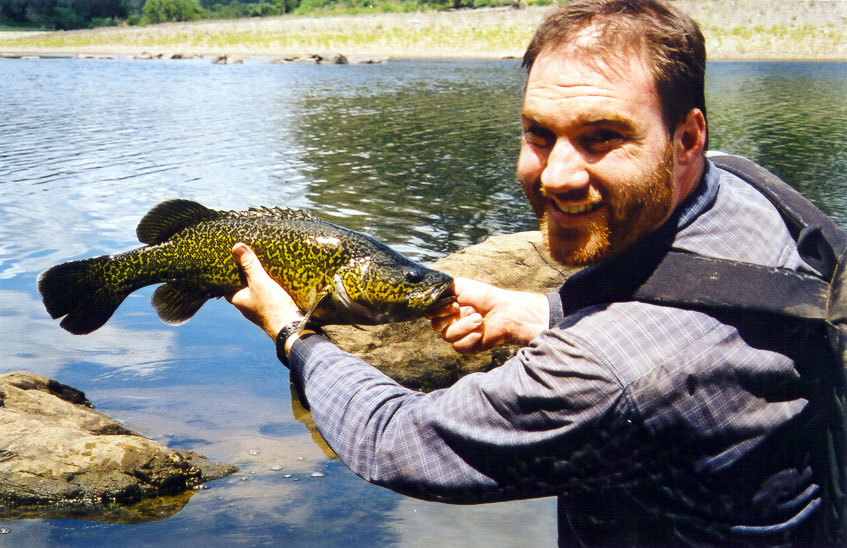If you have never done much freshwater fishing, you are in for a lot of fun when you get out on the water.You might not think you ‘like’ fishing a lot. But wait until you tie into that first largemouth bass, pike or musky. You will probably be ‘hooked’ for life!
As with any new hobby, there are some basic tips for freshwater fishing that will make success more likely, such as catching a seven pound largemouth bass, above. Read more below.
Depending on what you are fishing for, you should keep it pretty simple when you are just starting in freshwater fishing. First of all, get your fishing license, and then worry about tackle. I prefer a 6 foot spinning rod with 12 lb. test line, and spin-cast rod with 10 lb. test line.
I prefer the spinning rod for casting for pike and musky over open water, and the spin-cast rod for precision casting against the shore for bass. Others may recommend a baitcasting rod for precision casting. Other essentials include small and medium sized hooks for live bait fishing and rubber worms, a bobber or two, a red and white spoon for pike, jigs, a few spinners and plugs, and some sinkers. A net, a pair of pliers and a pocket knife, and you should be pretty well set.
I’ve done a lot of fishing on a particular small lake in Ontario, Canada since I was a boy. My brother used to complain about how I seemed to catch so many more fish than he did. The biggest reason was that I spent a lot of time on the water, and when I did, I kept my line wet. I always made sure I put out more casts than anyone else in the boat. And guess what? I caught more fish!
On a related note, you need to be patient when you are freshwater fishing. I rarely go out for less than three hours, and many days I spend at least six hours on the water. I also usually stay in a spot for at least half an hour before I consider moving.

You never know when you are going to hit a hot fishing spot. So you want to make sure you have everything in the boat you need. Fishing net, sunscreen, bug spray, water, a couple sandwiches, pliers, bait, lures, etc. I’ve had times when bass or pike fishing is so hot that I am hauling them in the boat, cast after cast. The last thing you want to do is have to leave at a moment like that!

Take note of the weather, phase of the moon, time and sky conditions when you have had fishing success.
Also, location is as important in freshwater fishing as it is in business. You need to know the habitat that your fish likes. Largemouth bass tend to feed on weedy shorelines with a lot of lily pads (above). Bass love to sit in wait under a bank with an overhang, and shoot out and grab a passing fish, worm or minnow. My favorite technique is to use a weighted rubber worm and cast it within a foot of a shallow, lily pad-lined bank, and then twitching it along.
Pike like submerged weed beds in 6-12 feet of water. This is a place where a good fish finder helps you a great deal – so that you can see where the weeds are. Musky like to sit in submerged weed beds as well and wait for passing prey. Walleye, on the other hand, prefer to swim along the bottom of sandy or rocky areas in 10-20 feet of water. A weighted jig with a worm or minnow is the best option here.
Also make sure that you keep a sharp eye for what is going on around you. Did you see a splash next to that lily pad? Drop a Rapala or a rubber worm next to it and see what happens. Do you see seagulls diving at a certain patch of water? There probably is a good reason for that.
Also, be aware of water temperature and the ideal temperatures for the species you are fishing. Bass prefer water between 65-75 degrees F, and pretty much stop feeding in water about 85 degrees.

Fish are very sensitive to noise. If you are banging around your boat, tossing the anchor noisily overboard, dropping tackle in the bottom of the boat….don’t be surprised if you go home empty handed that day.
There are days where the fish will prefer one color over another. I can’t tell you how many times when my purple rubber worm didn’t get a nibble, but then I switched to a red or pumpkinseed yellow worm, and the fish started jumping in the boat! You also can try different colors of spoons, jigs, and spinnerbaits. A spinner bait might have a silver spinner with a white roostertail. You can try another spinnerbait with a silver spinner and a red roostertail. Sometimes a small change in lure color can make a big difference.
![]()
Fishing at sun up and sundown seem to me to be very effective. This is really true for bass fishing. They really seem to like to feed in the morning and evening in the shallows. My favorite all time fishing is bass fishing in the evening in lily pads. Even if I do not catch anything, it is very peaceful and beautiful. Sun on the calm water, frogs croaking, fish splashing in the distance, sun sinking behind the trees. And if the fish start hitting, it gets even better!